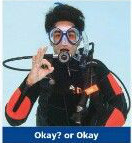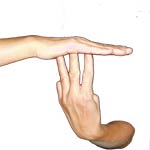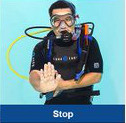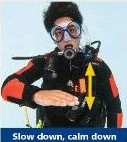Divers know that good communication is key to not only having an enjoyable dive, but also to completing a safe one. First and foremost, signaling is necessary to communicate intentions and give direction, such as whether to go up or down. Hand signals also help to maintain safety during a dive. One might ask their dive buddy if they’re okay, how much air they have, or signal a problem. Although divers use many hand signals, the most common ones are, unsurprisingly, the most important. In no particular order, here are some of the most common diving hand signals.
 I have a problem
I have a problem
This one is important because it is used to let your dive buddy or guide know that something’s wrong. To use this signal, put your hand out horizontally in front of you and tilt it side-to-side, (much as you would signal that something was “so-so” on land) then point to where you’re experiencing difficulty. You could be struggling to equalize your ears, or you may have a problem with your dive gear. This signal could mean a problem with anything. Inform your buddy quickly if something is wrong, so that you can either fix it or end the dive safely.
 Are you okay?
Are you okay?
Among the most common diving hand signals — and simple — this dive signal means “are you okay?” Both a question and an answer, you’ll make the “okay” sign just as you would on land, forming a circle with your thumb and index finger and raising your remaining three fingers. Most divers check with their buddy by using this hand gesture several times during a dive. It’s a great way to gauge your buddy’s comfort and maintain awareness of one another.
 Go up or go down
Go up or go down
It’s important to give and follow direction throughout a dive. This is why you must know your “go up” and “go down” signals, which are nothing more than thumbs-up and thumbs-down hand signs. If you’re going to ascend or descend it must be a collective decision. This way all divers act together to maintain the buddy system and ensure safety. Pay attention to your dive guide at the beginning of the dive and near the end, particularly.
 Three-minute safety stop
Three-minute safety stop
Also important is the three-minute safety stop signal. The dive guide gives this at the end of the dive. To do this, you hold one hand horizontally on top of three vertically positioned fingers on the opposite hand, with those three fingers meaning “three minutes.” It should be used on every dive to signal the safety stop, which is conducted at 10 to 20 feet (3 to 6 m).
 How much air do you have?
How much air do you have?
Divers should check their air supply every few minutes. It’s a good idea to stay on top of your dive buddy’s air levels too. To ask them how much air they have, you’ll tap two fingers lightly onto the palm of your opposite hand, with your palm facing upward or outward. In response, your buddy will signal how much air he has by holding up fingers to represent the bar/psi shown on his gauge. A half-tank is indicated by making a “T” sign with your hands.
 Low on Air
Low on Air
If you’re running low on air, you must tell other divers so that you can perform your safety stop and ascend together. If you’re low on air, which is normally considered 70 bar/1000 psi, you create a fist with your hand and tap it your chest. This lets fellow divers and your guide know it’s time to finish the dive together.
 Stop
Stop
For whatever reason, divers sometimes need to stop. They may need to rest, change course, check out a critter or simply take a photo. If you want to signal “stop,” extend an arm out in front of you while holding your hand up palm facing out, as if to push something away. This signal is easily seen and will catch the attention of other divers to get your message across.
 Slow Down
Slow Down
Some excitable divers end up swimming way too fast through the water. This results either in fatigue or an exhausted buddy who’s trying their hardest to keep up. Diving isn’t a race, and if you want to slow down, you should know how to communicate this message. Use both hands to slowly make repeated pushing-down motions out in front of your torso, so that fellow divers can understand that the pace is too fast, or that you need a break from kicking.
 I’m Cold
I’m Cold
Since water sucks the heat from your body 25 times faster than air, body-core temperature can plummet before you’ve even noticed. Although this isn’t dangerous if you act quickly and appropriately, low body temperature can lead to hypothermia. Should you get too cold on a dive, inform fellow divers so that you can take proper measures to warm up. To signal that you’re cold, hug your body and shiver, emphasizing your up-and-down hand movements on your arms.
Reviewing common diving hand signals is always a good idea, and knowing how to properly execute them makes for safer, more enjoyable dives for everyone. These are just the most common hand signals for diving, but divers use many others. Nail the basics, and then you can get creative when it comes to all the ways to communicate underwater.










